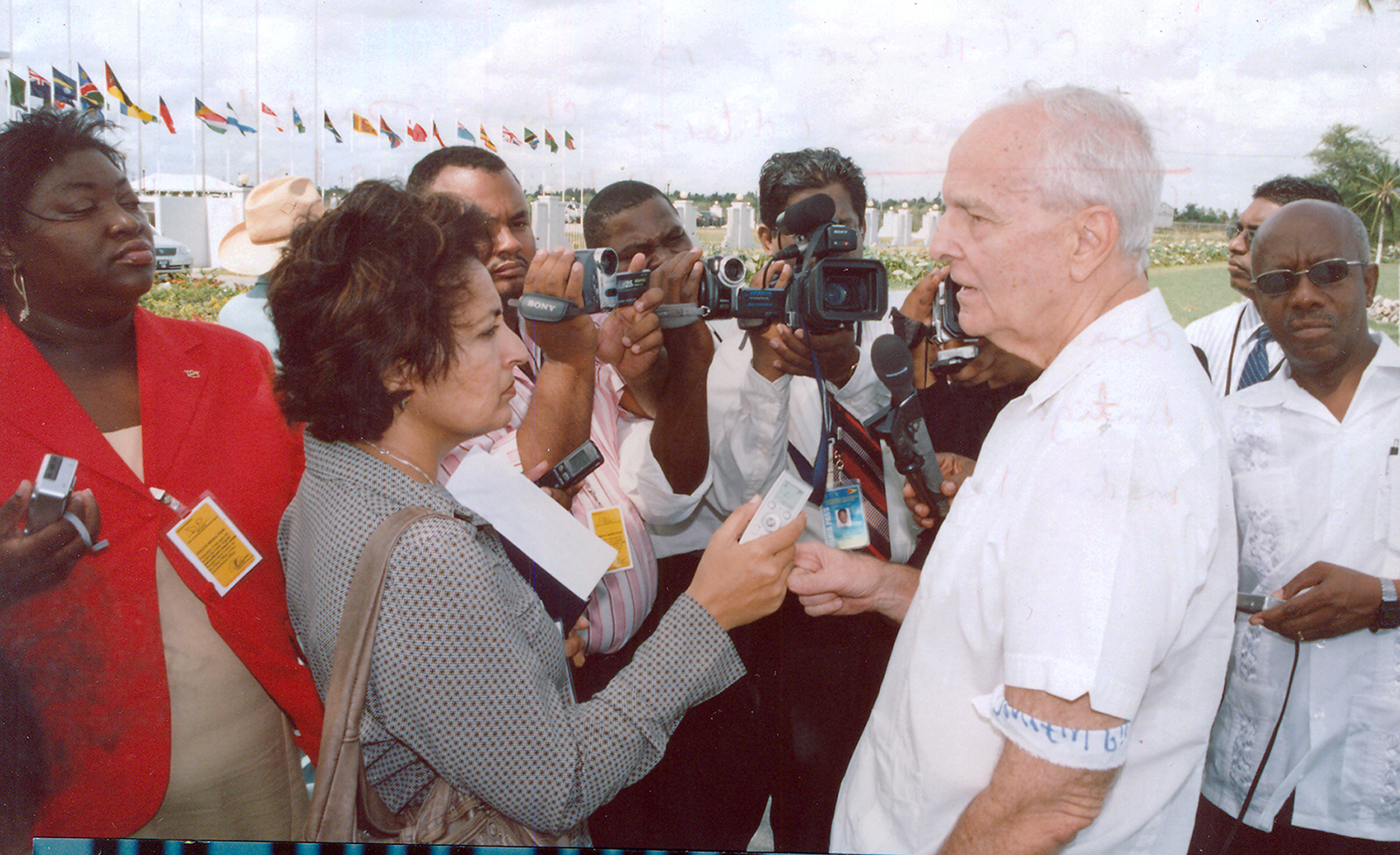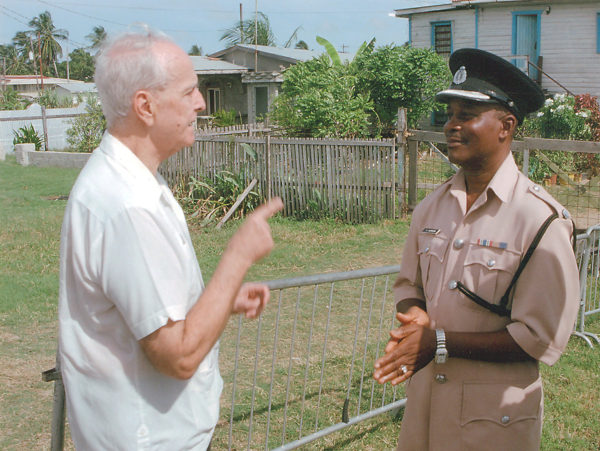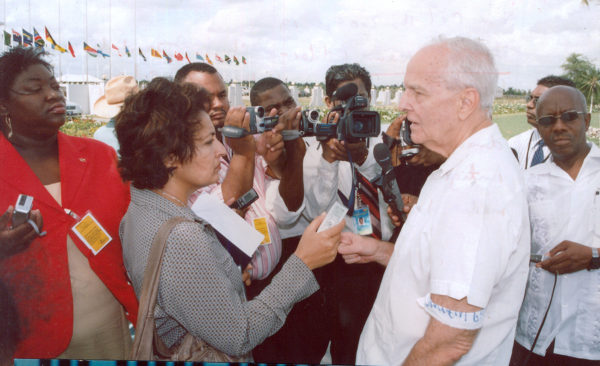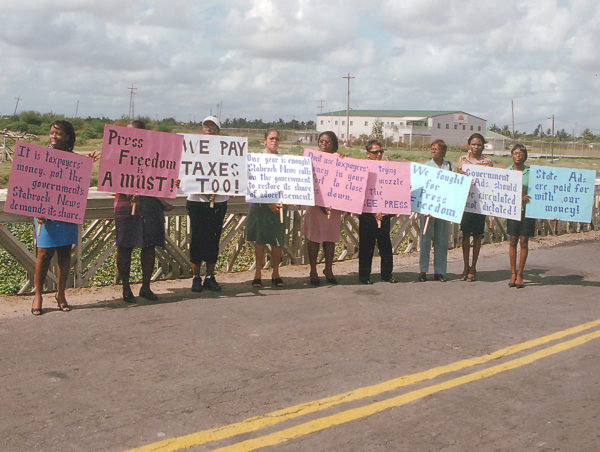November, 2016 marks the 10th anniversary of a 17-month withdrawal of state advertising from Stabroek News by the Jagdeo administration in what has come to be seen as the most serious attack on press freedom during the period of PPP/C governance from 1992 to 2015.
The withdrawal of the state ads began just months after the August 2006 general elections and followed severe attacks on Stabroek News by then president Bharrat Jagdeo and government officials on a variety of issues including columns that were being carried in the newspaper for leaders of the Alliance for Change (AFC).
After Stabroek News went public about the cutoff of the advertising in January of 2007, there was an outpouring of condemnation of the government’s actions from civil society groups here, international press bodies and regional newspapers. The Inter-American Press Association and the Inter-American Commission on Human Rights (IACHR) were among the regional institutions that raised their voices on the matter.
Given his tight control of the government, it was believed that the decision to end ads to Stabroek News came directly from Jagdeo. The intention behind the cutoff to Stabroek News became clear when plans for the launching of a newspaper by Jagdeo’s friend, Ranjisinghi Ramroop were announced. Analysts say the withholding of ads to Stabroek News was aimed at forcing it out of business and to clear the way for the Guyana Times which was eventually launched on June 5, 2008. This date was also significant to the end of the 17-month boycott as it cleared the way for the government to begin advertising with the Guyana Times.
The only major PPP official to raise a dissenting voice to the boycott was the late, former president Janet Jagan who was a longtime journalist and edited the Mirror newspaper for many years. In one of her columns in that paper she called for an end to the boycott prompting the oft-repeated rejoinder from Jagdeo that Mrs Jagan was now a “private citizen”.
How it started
In November of 2006, the Government Information Agency (GINA), which was the clearing house for the placement of state ads, suddenly stopped bookings to Stabroek News without explanation. It continued supplying ads in large quantities to the state-owned Guyana Chronicle, the Kaieteur News and the Mirror newspaper.
After more than two months of no ads, Stabroek News wrote to GINA’s then Director Dr Prem Misir for an explanation and pointed to the fact that Guyana was a signatory to the Declaration of Chapultepec on press freedom which proscribed the use of state ads as a means of rewarding or punishing journalists. GINA provided no explanation and this led Guyana Publications Inc (GPI), the publishers of Stabroek News and the Sunday Stabroek to issue a statement on January 9, 2007 in which the late Editor-in-Chief and founder of the newspaper David de Caires said that the decision by the PPP/C government to withdraw the ads, “constituted an apparent reversal of its policy of respect for freedom of expression and constituted an attack on the free press.”
The GPI press release was dispatched to the International Press Institute (IPI), the Commonwealth Press Union, the Inter-American Press Association and Caribbean newspapers among others.
The GPI statement prompted the PPP/C government to release a statement on January 15, 2007 in which it said that Stabroek News no longer had the highest circulation of private newspapers. It stated that the basis for the placement of government advertising was linked to the public’s response to those ads and that “huge” responses emanated from advertisements placed in the Kaieteur News and the Guyana Chronicle. None of these statements by the government was supported by evidence and this was a point that Stabroek News highlighted throughout the entire period of the boycott. The newspaper had called for professional agencies to be assigned the task of determining the circulation of the various newspapers and how state ads should be allocated and that this shouldn’t be in the hands of a government agency. de Caires had also made the point that Stabroek News was entitled to a portion of the taxpayer-funded ads given its readership.
For all of 2007, the Jagdeo administration refused to budge from its position despite broad condemnation of the government’s action from IPI, the Guyana Press Association, the Association of Caribbean Media Workers, the Guyana Human Rights Association, the Private Sector Commission, the Trades Union Congress, Reporters Sans Frontieres, the Barbados Nation and the Jamaica Gleaner among others.
To the contrary, the government’s campaign intensified when it brought pressure on the Guyana Sugar Corporation and the Guyana Power and Light to cease advertising with SN. Neither state company provided an explanation for this.
As part of its campaign against the boycott, Stabroek News ran a banner on its front page on a daily basis charging the government with abusing taxpayer funds by withholding ads from the newspaper. It upped its campaign by staging a protest on October 15, 2007 against the PPP/C government outside of the Arthur Chung Convention Centre where a meeting of Commonwealth Finance Ministers was taking place. This was SN’s first protest against any government in its then 21-year history and it appeared to unnerve the administration. The police were instructed to prevent placards and banners from being used in the protest and dozens of Stabroek News employees and supporters were forced to use newspapers to make their point.
Full impact
Some of the placards read “We pay taxes too”, “State ads are paid for with our money”, “Government ads should be circulated, not dictated”, “We shall not be silenced, we will continue to tell the truth”, and “Our liberties depend on freedom of the press.”
Noting at the protest that it was almost one year since the government pulled its ads from the Stabroek News, de Caires told the regional and international media that had gathered for the meeting that it was hard to estimate the full impact that the withdrawal of the ads from 29 government ministries and state agencies had had on the newspaper but added that it accounted for 20% of the gross advertising revenue.
“We are running a tight ship,” he said noting that the advertising revenue was not President Jagdeo’s money, “It is my money, your money, our money.”
Days after the Stabroek News protest, on October 27 in her Mirror column, Mrs Jagan re-stated her call from February, 2007 for an end to the withdrawal of government advertising from Stabroek News.
She said that despite her strong criticism of Stabroek News “I repeat my earlier call for the end of the advertisement ban on that newspaper”.
Despite all these calls and the intervention of the IACHR rapporteur on press freedom, the Jagdeo administration remained unmoved.
The ad boycott continued into 2008 until April of that year when it abruptly ended without explanation.
de Caires said then that a very senior government official had rung him days before and indicated that Stabroek News would begin receiving ads from ministries and other agencies starting that week.
“No reason was given for the change in policy,” de Caires said. Nevertheless, he welcomed the change in the government’s position.
Seventeen months after it instituted the draconian ban on state advertising in SN, the PPP/C government had relented. However, it was soon to be seen that the resumption of advertising wasn’t necessarily as a result of any pressure that the government felt or because of the castigation of its stance here, in the region and further afield. The Guyana Times newspaper, founded by the Ramroop Group which has close ties to Jagdeo, was preparing to set off and state advertisements would be an important revenue source for them.
The Ramroop Group duly launched the Guyana Times newspaper on June 5, 2008 when there was a public spat between Jagdeo and businessman Yesu Persaud over tax concessions to businesses where it was later determined that Jagdeo was wrong in his asseverations. It was clear that in a short period of time the Guyana Times would begin receiving ads when the criteria which had been used to stop ads to SN for 17 months would have meant that the Ramroop paper should not have access to state ads.
Less than a year after its launch, the Guyana Times began receiving state ads from GINA. When Stabroek News inquired from the GINA Advertising Unit as to the basis for this, it was told that it had “no obligation to explain its placement of advertisements to the Stabroek News”. This newspaper then began a meticulous count of state advertising supplied by GINA to the four daily newspapers and published these figures on a monthly basis.
In a matter of just under two years after its launch, the Ramroop newspaper at April of 2010 was already receiving 22% of state advertising. This was equal to the amount of state advertising that Stabroek News was receiving and five percentage points above the Kaieteur News which had been the previous favourite of the government. By this time Jagdeo had fallen out with the Kaieteur News which had originally supported his decision to cut off ads to Stabroek News. Throughout this period, the lion’s share of the ads went to the state-owned Guyana Chronicle.
Tabulation
With Stabroek News’ monthly tabulation of the distribution of state advertising placing the government under pressure, there would be another twist in this saga which would persist through the end of the Jagdeo administration in 2011 and continue through the Donald Ramotar administration up to 2015. In August, 2010 the government suddenly announced that state advertising would now be placed on the internet and only the state-owned newspaper and a weekly paper – the PPP/C aligned Mirror newspaper would receive ads. Costs and the need to take advantage of digital technology were the reasons advanced by then Head of the Presidential Secretariat Dr Roger Luncheon.
Effectively from September 2010, state ads were cut off to the three private newspapers: SN, KN and the Guyana Times. It meant that in a matter of four years the government had zigzagged through several policy changes on state advertising and mainly to punish or to favour certain newspapers, a clear violation of the Declaration of Chapultepec which Jagdeo had signed. In the ensuing years there were occasional GINA ads placed with the private newspapers. These were ads that the state had an interest in such as announcements of visits by government officials and defence of its public positions.
Following its victory at the 2015 general elections, the APNU+AFC government has advertised broadly with all four of the daily newspapers. Around 40% of the state ads go to the state-owned Guyana Chronicle and the remainder is split among the three private newspapers.
Stabroek News Editor-in-Chief (EiC) Anand Persaud in an invited comment on the 10th anniversary of the withholding of state advertisements from the newspaper said it constituted a naked assault on press freedom by the Jagdeo administration and diminished the PPP/C government’s standing on this very important issue. He noted that it was all the more inexplicable as the PPP itself had been a victim of the harsh curtailment of press freedoms during the Burnham years.
Persaud added that the cutoff of ads also represented an abuse of power by former president Jagdeo’s administration as it could not arbitrarily and capriciously decide how taxpayer-funded state advertisements should be distributed. Persaud noted that it also crystallised how the government under Jagdeo’s control had set out to use taxpayers’ monies to benefit cronies to the detriment of sound, transparent and judicious policies. The EiC pointed out that the numerous shifts in how state ads were handled and the many inconsistent statements by the administration exposed its poor governance in this matter. He lamented that aside from Mrs Jagan no one else in the party or government stood up to Jagdeo’s pernicious handling of the state advertisements issue. The EiC added that Stabroek News’s experience was a cautionary tale for all parts of society on the abuse of basic freedoms in what was a democratically elected government.
Persaud stated that the newspaper had proudly stood up to the excesses of the Jagdeo administration and successfully internationalised its case to great effect.










